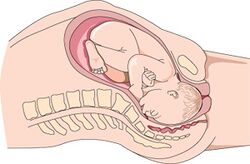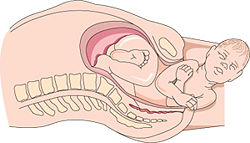Childbirth: Difference between revisions
imported>Mary Ash (Removed opinion not based on fact. At least no sources to back up opinion.) |
imported>Howard C. Berkowitz No edit summary |
||
| Line 1: | Line 1: | ||
{{subpages}} | {{subpages}} | ||
{{ | |||
{{TOC|right}} | |||
'''Childbirth''', or labor and delivery, is when a woman gives birth to a [[baby]]. Labor has three stages. The first stage of labor has two phases: latent and active. The second stage of labor is when the baby is born while the third stage of labor is when the placenta is delivered. | '''Childbirth''', or labor and delivery, is when a woman gives birth to a [[baby]]. Labor has three stages. The first stage of labor has two phases: latent and active. The second stage of labor is when the baby is born while the third stage of labor is when the placenta is delivered. | ||
== First stage of labor == | == Station == | ||
Station is measured by where the baby's head is located in reference to the woman's ischial spines. Measurements above the ischial spines are reported as -1 to -5. Once the baby's head engages into the pelvis, or at 0 station, the baby's placement within the birth canal will be written in positive numbers. The numbers for the positive station are written as +1 to +5. | |||
== Second stage of labor == | ==Vaginal delivery== | ||
===First stage of labor=== | |||
{{Image|Labor-pelvis.jpg|left|250px|Most babies enter the [[birth canal]] facing sideways and the head turns face down.}} | |||
Triggered by the hormone [[oxytocin]], produced in the [[pituitary gland]], irregular contractions are felt during the latent phase of labor. The contractions will slowly become more regular and pain is minimal. The [[cervix]] will dilate and efface up to 4 [[centimeter]]s during the latent phase of labor. First time mothers will on average labor 8 hours during the latent phase. Mothers who have borne previous children typically have shorter labor during the latent phase. Towards the end of this stage a woman will enter the transition phase. During this part of labor the cervix will continue to dilate to 10 centimeters. This is probably the most painful part of the labor process. | |||
====Cervical dilation==== | |||
Measurement of the cervix is recorded from 0 to 10 centimeters. The cervix is considered complete when it reaches 10 centimeters. | |||
The cervix shortens in preparation for birth. The normal uneffaced average cervical length is between 3.5 to 4.0 centimeters. | |||
====Fetal monitoring==== | |||
====Delaying the first stage==== | |||
If a birth is premature or there are medical reasons to delay vaginal delivery, [[tocolysis|tocolytic drugs]] may be used to suppress uterine contractions. Current agents used to delay premature uterine activity include [[magnesium sulfate]], [[oxytocin]] antagonists, [[calcium channel inhibitor]]s, and [[adrenergic beta-receptor agonist]]s. Ethyl alcohol is obsolete for tocolysis. | |||
===Second stage of labor=== | |||
The cervix is fully dilated and the woman begins to push to deliver the baby. This phase of labor can last up to two hours. The baby is delivered at the end of the second stage of labor. The [[umbilical cord]] is cut by the doctor once the delivery is finished.{{Image|Labor-head.jpg|right|250px|The head emerging from the birth canal.}} | The cervix is fully dilated and the woman begins to push to deliver the baby. This phase of labor can last up to two hours. The baby is delivered at the end of the second stage of labor. The [[umbilical cord]] is cut by the doctor once the delivery is finished.{{Image|Labor-head.jpg|right|250px|The head emerging from the birth canal.}} | ||
== Third stage of labor == | ====Episiotomy==== | ||
A small incision, or cut, used to enlarge the vaginal opening. The cut is made from the vaginal to anus. The person performing the delivery sutures the area once the delivery is finished. This is not always done during a vaginal delivery, and, indeed, is quite controversial. | |||
===Third stage of labor=== | |||
The [[placenta]] is delivered during the third stage of labor. Usually this phase of labor takes between 5 to 20 minutes. | The [[placenta]] is delivered during the third stage of labor. Usually this phase of labor takes between 5 to 20 minutes. | ||
== Cesarean section == | == Cesarean section == | ||
The cesarean is when a baby is surgically removed from the uterus. Most cesarean section usually takes up to an hour to complete. The surgeon normally makes two cuts in the lower abdomen before making an incision in the uterus. The baby is removed from the uterus and the umbilical cord is cut. | The cesarean is when a baby is surgically removed from the uterus. Most cesarean section usually takes up to an hour to complete. The surgeon normally makes two cuts in the lower abdomen before making an incision in the uterus. The baby is removed from the uterus and the umbilical cord is cut. | ||
Revision as of 18:52, 3 August 2010
Childbirth, or labor and delivery, is when a woman gives birth to a baby. Labor has three stages. The first stage of labor has two phases: latent and active. The second stage of labor is when the baby is born while the third stage of labor is when the placenta is delivered.
Station
Station is measured by where the baby's head is located in reference to the woman's ischial spines. Measurements above the ischial spines are reported as -1 to -5. Once the baby's head engages into the pelvis, or at 0 station, the baby's placement within the birth canal will be written in positive numbers. The numbers for the positive station are written as +1 to +5.
Vaginal delivery
First stage of labor

Most babies enter the birth canal facing sideways and the head turns face down.
Triggered by the hormone oxytocin, produced in the pituitary gland, irregular contractions are felt during the latent phase of labor. The contractions will slowly become more regular and pain is minimal. The cervix will dilate and efface up to 4 centimeters during the latent phase of labor. First time mothers will on average labor 8 hours during the latent phase. Mothers who have borne previous children typically have shorter labor during the latent phase. Towards the end of this stage a woman will enter the transition phase. During this part of labor the cervix will continue to dilate to 10 centimeters. This is probably the most painful part of the labor process.
Cervical dilation
Measurement of the cervix is recorded from 0 to 10 centimeters. The cervix is considered complete when it reaches 10 centimeters.
The cervix shortens in preparation for birth. The normal uneffaced average cervical length is between 3.5 to 4.0 centimeters.
Fetal monitoring
Delaying the first stage
If a birth is premature or there are medical reasons to delay vaginal delivery, tocolytic drugs may be used to suppress uterine contractions. Current agents used to delay premature uterine activity include magnesium sulfate, oxytocin antagonists, calcium channel inhibitors, and adrenergic beta-receptor agonists. Ethyl alcohol is obsolete for tocolysis.
Second stage of labor
The cervix is fully dilated and the woman begins to push to deliver the baby. This phase of labor can last up to two hours. The baby is delivered at the end of the second stage of labor. The umbilical cord is cut by the doctor once the delivery is finished.
Episiotomy
A small incision, or cut, used to enlarge the vaginal opening. The cut is made from the vaginal to anus. The person performing the delivery sutures the area once the delivery is finished. This is not always done during a vaginal delivery, and, indeed, is quite controversial.
Third stage of labor
The placenta is delivered during the third stage of labor. Usually this phase of labor takes between 5 to 20 minutes.
Cesarean section
The cesarean is when a baby is surgically removed from the uterus. Most cesarean section usually takes up to an hour to complete. The surgeon normally makes two cuts in the lower abdomen before making an incision in the uterus. The baby is removed from the uterus and the umbilical cord is cut.
